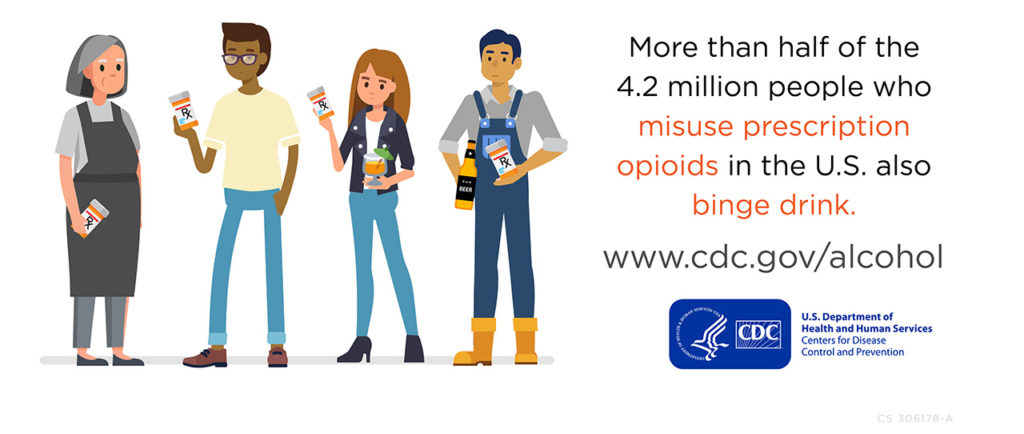
Millions of Americans at increased risk of overdose and death
More than half of the 4.2 million Americans who misused prescription opioids between 2012 and 2014 also engaged in binge drinking, according to a new studyexternal icon released today by the Centers for Disease Control and Prevention (CDC) in the American Journal of Preventive Medicineexternal icon.
Binge drinking is the consumption of four or more drinks for women, or five or more drinks for men, on an occasion. Prescription opioid misuse is the use of these drugs without a prescription, or use only for the feeling the drug causes.
CDC’s analysis shows that people who binge drank were nearly twice as likely to misuse prescription opioids as non-drinkers, even after taking into account other factors that could affect the relationship between prescription opioid misuse and binge drinking, like age and sex.
“We are losing far too many Americans each day from overdoses,” said CDC Director Robert R. Redfield, M.D. “Combining alcohol and opioids can significantly increase the risk of overdoses and deaths.”
For this report, CDC scientists analyzed data for 2012, 2013, and 2014 on self-reported binge drinking and prescription opioid misuse during the past 30 days from the National Survey on Drug Use and Health.
Prescription opioid misuse among people who binge drank varied by age and social factors
- While young people who binge drank had higher rates of prescription opioid misuse, 2 in 3 people who binge drank and misused prescription opioids were age 26 years and older.
- Prescription opioid misuse was more common among people who binge drank with lower education and income levels.
- Prescription opioid misuse increased with the frequency of binge drinking.
What can be done to reduce binge drinking and prescription opioid misuse?
A comprehensive and coordinated approach to preventing binge drinking and prescription opioid misuse could help to reduce the risk of drug overdoses.
Effective community prevention strategies for reducing binge drinking include limiting the number of places that sell alcoholexternal icon in neighborhoods, legal liabilityexternal icon for places that illegally serve underage or intoxicated patrons, and maintaining limits on the daysexternal icon and hoursexternal icon when alcohol can be sold. Effective strategies for reducing overdoses involving prescription opioids include following opioid prescribing guidelines, such as the CDC Guideline for Prescribing Opioids for Chronic Pain, as well as strategies to prevent and treat opioid use disorders.
This is a press release from the CDC


Chattooga Local News
Carr Convicts 16 in Barrow County, Shuts Down Prison Gang Operation

Bulloch Public Safety
12/04/2025 Booking Report for Bulloch County

Bulloch Public Safety
12/02/2025 Booking Report for Bulloch County

Bulloch Public Safety
11/10/2025 Booking Report for Bulloch County

Bulloch Public Safety
11/24/2025 Booking Report for Bulloch County

Bulloch Public Safety
11/06/2025 Booking Report for Bulloch County

Bulloch Public Safety
11/12/2025 Booking Report for Bulloch County

Bulloch Public Safety
12/01/2025 Booking Report for Bulloch County






